By site editor Dan Chung:
Imagine being in a chaotic breaking news event and getting smooth tracking shots any time you want. Imagine getting graceful moving images of your reporter or your subjects without a Steadicam or a bulky brushless gimbal. Imagine being able to get stable shots from a moving car, boat, plane or helicopter with a tiny inexpensive setup. Imagine putting your camera on a monopod and getting stabilised shots from six feet about you.
Even a few months ago this was all unthinkable. Now you don’t need to imagine any more.
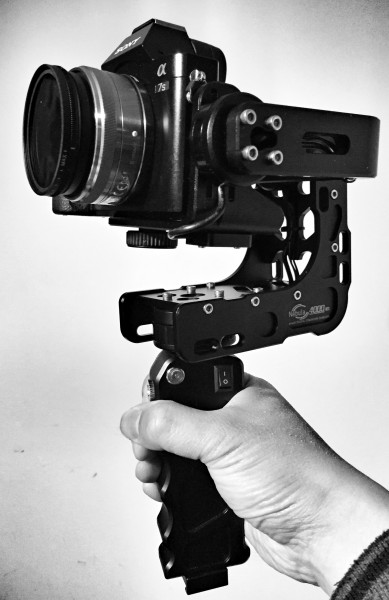
Chinese company Filmpower are the first to the market with a handgrip style brushless gimbal for compact system cameras. Despite other companies such as Big Balance showing similar designs at NAB early in the year, nothing else actually seems to be on sale yet. The $699 Nebula 4000 Lite gimbal works with the BMPCC, Sony a7S, Panasonic GH4 and other similar sized cameras.
For news and documentary shooters I think this gimbal is a very big deal. I would even go as far as to say the words I hate to use – ‘game changing’. Why? Because the Nebula 4000 is the first brushless gimbal that you can easily throw into a shoulder bag all set up and ready to go. It comes at the same time that small cameras like the a7S and GH4 have finally become good enough for professional use. The Nebula 4000 is compact enough that you can keep it with you at all times, just reaching into your bag and grabbing it as the need arises. Unlike my trusty Steadicam Merlin it doesn’t need constant calibration and it doesn’t need as much training and practicing to get right (that said, I still think the Merlin is a better tool for many shots if you know how to use it, thanks to the bigger payload and less mechanical looking movements).
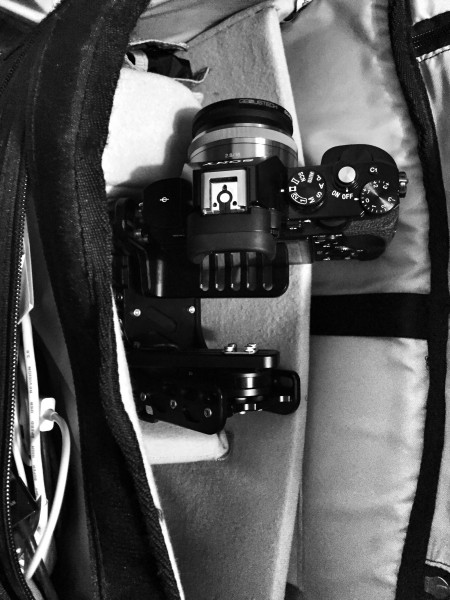
The Nebula 4000 Lite has a specified payload of up to 1kg – although the lighter the setup you use, the less strain on the motors and the easier the operation. It comes with an adapter for iPhones in the box and GoPros can also work with it. I decided to keep things simple and opted for an a7S with Sony’s APS-C crop 16mm f2.8 pancake lens. This was combined using a step-up ring with the excellent 52mm variable ND from Genus.
The video above is shot with the a7S and 16mm in crop mode at 50fps and then slowed 50% in post. Most of the time I use manual focus but occasionally play with the AF too – although it is a bit hit and miss with the 16mm. In future I’d like to try the little Zeiss 35mm f2 Loxia lens and the Sony/Zeiss 35mm f2.8 FE lens to see if either will work well in this setup.
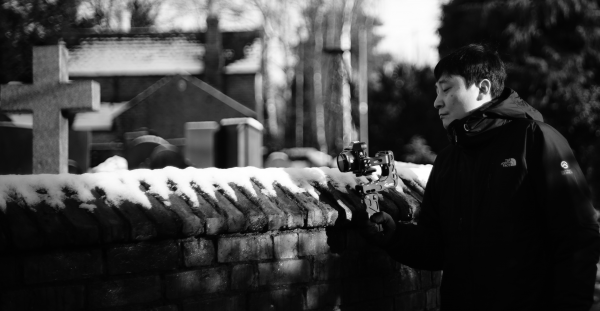
The quality of the metalwork, the paintwork, the laser etched logo and the nice ABS case the Nebula 4000 comes in all give the impression of a quality product. The documentation on the other hand is somewhat sparse and I had to resort to online tutorials and videos to get up and running.
The gimbal has three-axis stabilisation and looks very much like it came straight off a quadcopter and had a handle attached to it. The three brushless motors control pitch, yaw and roll and are run by a controller chip that uses open source code. This is the same system used by most other gimbals on the market, apart from higher end offerings like Freefly’s MoVI and DJI’s Ronin. It can be tuned using freely available software called SimpleBGC, either via a wired USB connection to your PC, or Bluetooth to your Mac/PC or Android device (on a Mac you have to run the app using Java). The design does also make it a little hard to see the rear screen of my a7S from some angles and if you are going to use it for more than just a grab-and-go device then I would recommend adding an external monitor.
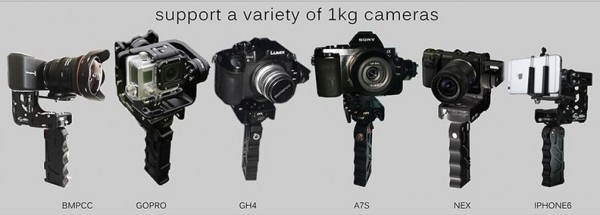
The gimbal is self contained and there are a minimum of cables showing. One word of caution – don’t spin any of the motors too far around as there are wires connecting inside that you risk damaging by rotating too far. The Nebula 4000 has a built in rechargeable battery housed in the handgrip. I haven’t timed exactly how long it lasts in normal use but I imagine it must be around half an hour. If the runtime is too short Nebula have just introduced an external battery pack option that can bolt onto the base of the grip. The grip itself has 1/4 20 threads and a 3/8 thread on its base for attaching accessories or mounting to other gear – more on this later.
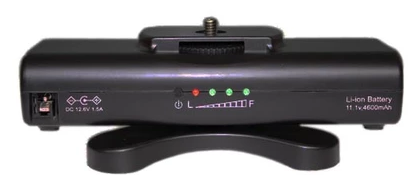
By default there are three basic modes – follow mode, where the camera attempts to follow your hand movement as you move it up, down, left and right; semi-follow mode, where the pitch and roll are locked but the camera follows the yaw movements side to side; and lock mode, where all axes are locked and the gimbal tries to keep the camera pointing permanently in the same direction. If you tilt the camera too far over to the left or right side it will go out of range and the gimbal will become unstable – the specs say camera should not bank more than 60 degrees in either direction.
In use I find shots from a well-set-up Nebula 4000 to look not unlike those from larger gimbals – if it is used correctly, you can pass them off as being filmed on something much larger and more expensive. That said, results occasionally tend to look a little mechanical and are perhaps not as fluid as footage I’ve seen from the likes of the MoVI M5. The single handgrip makes it harder to precisely control movements and when walking there is often clear evidence of the steps I take – no matter how hard I try to move smoothly and grip the gimbal lightly. This is something my little Steadicam Merlin handles better – but I wonder if that is just because I am more accustomed to operating it. I’ve considered adding a Manfrotto Figrig to the Nebula to give better grip and more control. Cameraman and blogger Erik Naso has already done this and you can see what he achieved here.
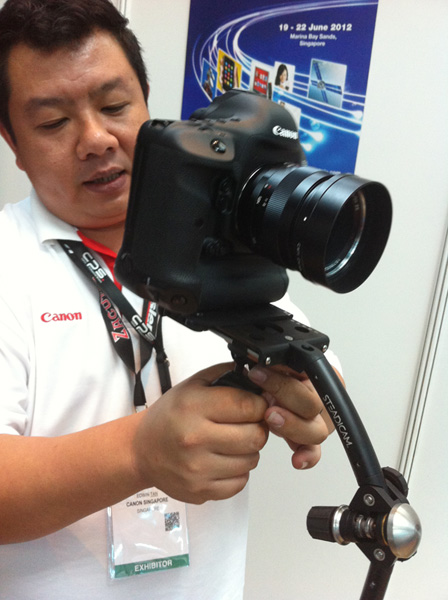
A Steadicam also wins when you are panning left or right and want to finish in an exact position. In either follow or semi-follow mode the Nebula, like most other brushless gimbals, has an adjustable latency between you starting or ending a move and the camera actually following you. What you learn to do is work with the lag time by anticipating the motion. This is really quite hard to do with the Nebula and I can see why Hollywood MoVI or DJI Ronin operators often prefer to have a second operator direct the camera via remote control. Sadly there is not a remote control option for the tiny Nebula – but then, that isn’t really the point of it. After several weeks of using it I can now get most of the moves I want to make out of the Nebula – but it often takes several attempts. In the video below I used the Merlin with a C100 in Dual Pixel CMOS AF for all the Steadicam shots (which start about a minute into it) – I still think the result looks more fluid than what I’m currently getting from the Nebula in many situations:
Just like a Steadicam, the best looking moves with gimbals are ones that are well planned and executed. You can use the Nebula to just follow your subject around aimlessly, but the gimbal is capable of so much more. By moving slowly and carefully you can make moves that look similar to small slider movements or graceful dolly shots. One trick I have used a lot is to shoot slow motion at 50 or 60P and then conform the footage to 25P (I’m in PAL world).
Balancing your camera on the gimbal is key. The gimbal must be balanced on all three axes and the camera itself needs to be balanced on the camera tray as well. If you don’t do this the motors will strain and the whole thing will be unwieldy. Unlike most larger brushless gimbals, the Nebula 4000 Lite needs an allen key to adjust the balance of the camera. This makes quick adjustments hard, but on the other hand means the gimbal is pretty locked down and settings don’t get accidentally altered as it rolls around in your gadget bag.
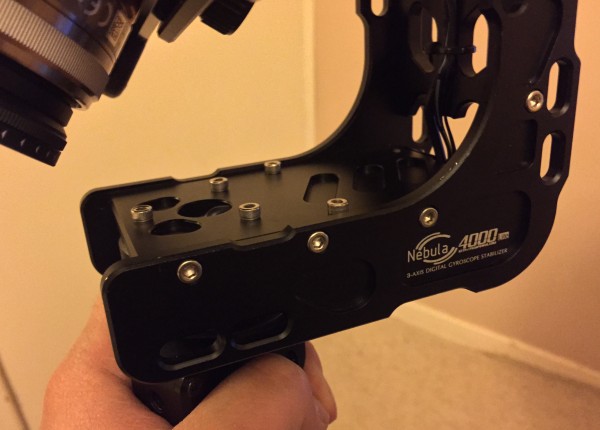
The physical range of adjustment of the gimbal is also limiting – especially on the yaw axis where there are only a few holes to choose from and the camera can only move so far backwards. This restriction rules out proper balance with larger lenses with my a7S on the Nebula. It will work if not correctly pan balanced but will strain the motors more as they try to compensate and I wouldn’t recommend it. With a camera the size of the a7S the Nebula motors never seem to keep the camera as rigidly in place as other larger gimbals either – more care is required and an accidental knock will send it crazy. Sticking to one small lens and camera combination will also simplify your life greatly, as rebalancing for different setups takes time.
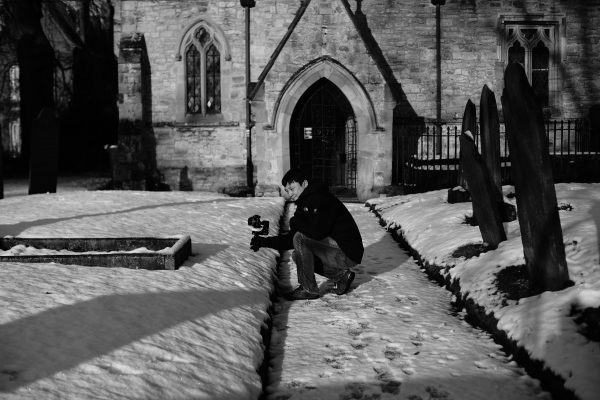
I had a few problems getting a stable image out of the Nebula 4000 out of the box. Filmpower claim the factory settings should be good to go for most small cameras – I have to disagree. I was simply getting too jittery an image. Also, every time I tilted the camera up it would vibrate and then go out of control. Because my Nebula 4000 was from an early batch I suspect newer ones may have improved settings – but I can’t be sure. Jitter in the corners of the frame is one of the tell tale signs that you are using electronic stabilisation and to my eyes looks very un-filmic.
I had a little moan about this on Twitter and was amazed when Filmpower contacted me and offered to send a technician around to my office in Beijing to calibrate it. A day later, Mr Fan arrived at my door, connected the gimbal to Simple BGC software running on my Mac, spent an hour or so playing with various settings and then pronounced the gimbal fit to fly.
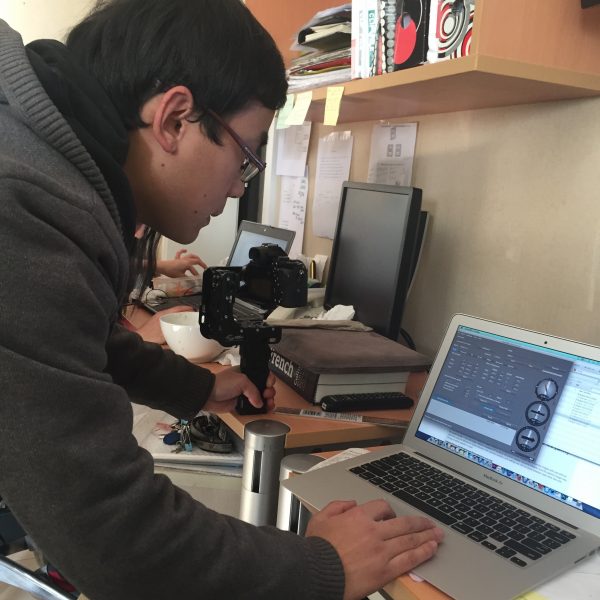
The freshly calibrated gimbal was a great improvement and I immediately put it to work. The video below was shot with the new settings on the same day Mr Fan visited. There is still some jitter in the corners of the frame but it was a particularly windy day and that probably had something to do with it. The shots from the motorised tricycle really impressed me as the ride wasn’t especially smooth. The gimbal could now shoot directly up into the sky and downwards too – as you can see from the video.
Below is a screen grab of his setup:
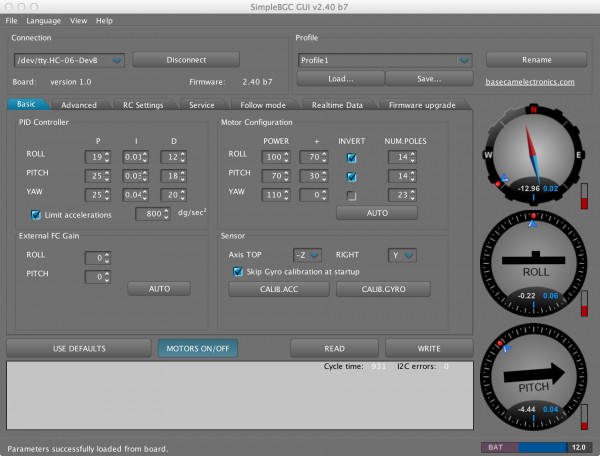
I have shot quite a few things with the gimbal using Mr Fan’s settings. These include several walk-and-talk pieces with a reporter. The gimbal performed well and I was pretty happy with the results. However, as I used the Nebula more I found that it still wasn’t quite set up to my liking. I decided to attempt tuning the gimbal using the SimpleBGC software myself. I had a great conversation with fellow Nebula owner Christopher Mayer who made some suggestions on how to improve things further.
I won’t go into too much detail here as there are several handy guides online that can guide you through the process. In simple terms, each motor has a power setting that you can adjust. You would imagine that using maximum power is the best option – but this generally isn’t the case and excessively strong motor power will induce vibrations into the system. There are three main settings called P, I and D for each motor and these control the way in which the motors respond to movements and vibrations. They do not work in isolation to each other – there is some magic required to find the perfect combination. There are several other settings that affect the responsiveness of the gimbal in follow mode.
The SimpleBGC software allows you to save settings to your computer and re-load them later – you should save the default Filmpower settings before you start tinkering so you can go back to them at any point. There is an excellent, but very long tutorial on how to adjust the Nebula 4000 Lite here:
After several hours of playing around I cooked up my own settings for the a7S + 16mm combo which seem to work well. They did a good job of reducing jitter while allowing the camera to point directly up and down without inducing too much vibration. In general I aimed for higher P and D values, with a low I value and medium motor power. These are the settings I ended up with:
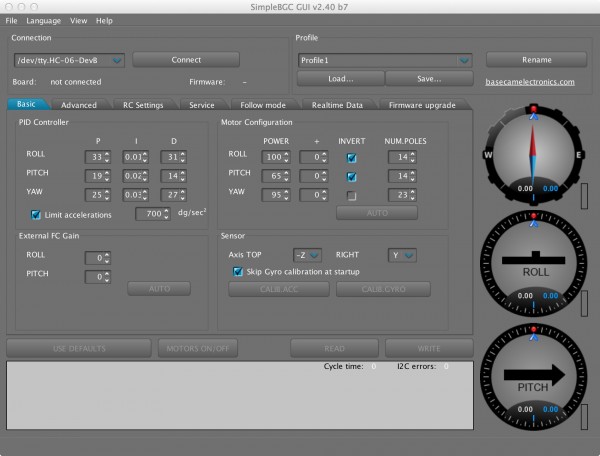
Note that the check box for the top motor is now set as ‘inverted’ – this was not how the gimbal arrived. Also note that I changed the gimbal to be a bit more responsive in follow mode – this is my personal preference and you may prefer a slower response.
A word of caution – even if you have the same camera + lens and settings as mine there is no guarantee my settings will work for you. Christopher Mayer sent me settings that work perfectly for him, but they didn’t work at all on my gimbal. It seems likely that there is some variation between different Nebula 4000s. Rather than use someone else’s settings from the internet it will be far better to learn how to calibrate the gimbal properly yourself.
The Nebula has a few other neat tricks. If properly set up it can be run upside down by simply flipping it over slowly – although plenty of other users have not managed to set their Nebulas up to work this way. You can also go into SimpleBGC and program the gimbal to work inverted – you can attach grips and a monitor or recorder to the inverted handle and it will function much more like a regular brushless gimbal. Getting a monitor to work will however require a special ultra thin HDMI cable as there is very little clearance between the side of the camera and the gimbal itself. These can be bought from Filmpower and several other Quadcopter specialists.
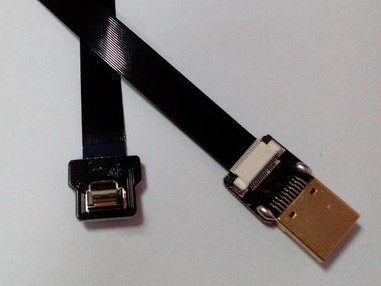
Another trick is to attach the gimbal’s grip to a monopod and hold your camera aloft to get a nice stabilised high viewpoint. This would be very handy in news situations and something I wish I’d had whilst covering protests in the past. You can also add a small hot shoe mount to the base of the gimbal instead and use it to attach a wireless mic – great for the walk-and-talk pieces to camera that are the mainstay of most nightly news programmes. Stabilised shooting from moving vehicles is also a key selling point for the Nebula for news and documentary filming, and probably reason enough alone to get one, considering the asking price.
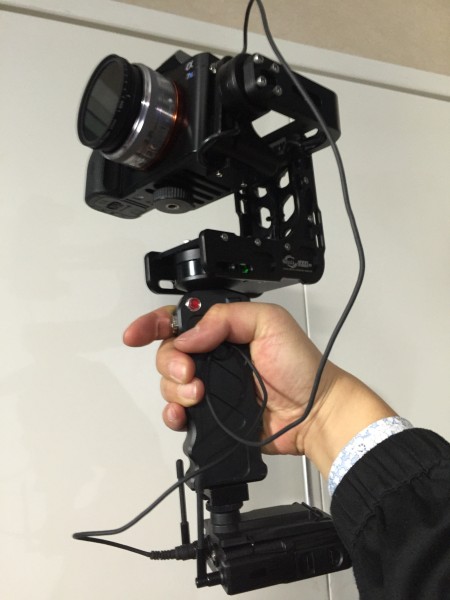
Lastly, one really great use of the Nebula doesn’t involve much motion at all. It works really well for pulling off fake tripod shots and also for the odd pan or tilt shot. Not as good as a proper tripod, but very usable none the less.
The Nebula 4000 Lite is surely the first of what I’m sure will be many brushless gimbals to come in this form factor. I’m sure they will get better, more powerful and cheaper in a very short space of time. I hope newer models will take a slightly higher payload and have easier calibration – but what you can already do with the Nebula 4000 is pretty amazing. Will this replace my larger gimbals and my Steadicam? Not really. I will continue to use the Merlin for many things, not least because it can carry a C100 with its amazing AF system. For set piece shoots where I have the time and energy I will still set up a bigger gimbal or Steadicam. But for grab-and-go shooting, fly-on-the-wall documentary and stealing the odd shot during regular shoots the Nebula is the perfect addition to my kit bag. At the asking price I think they will sell a ton of them.





